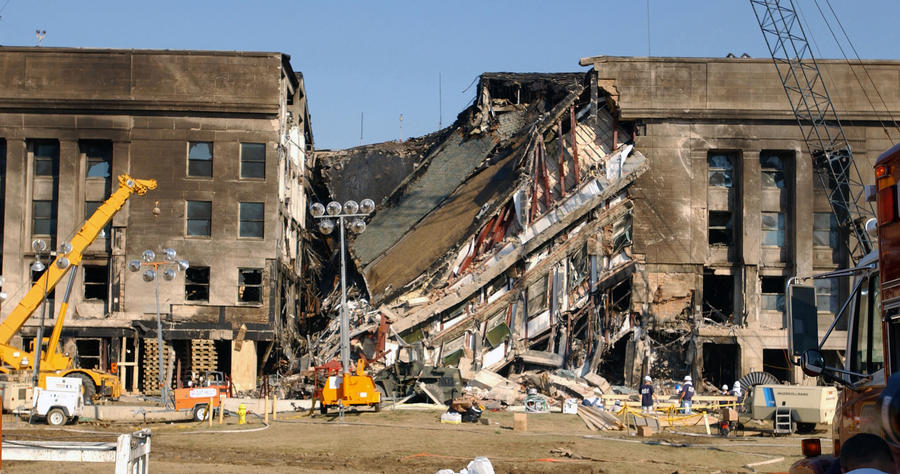A general’s story and reflections on 9/11
Illustration: Chris Gash
General John P. Jumper, former Leidos Chairman and CEO, was Air Force Chief of Staff on Tuesday, September 11, 2001. The Senate had confirmed his nomination five days earlier. It was his first day at the Pentagon.
Twenty years later, this is his account:
At 8:30 a.m., Jumper convened his first staff meeting in a basement command center at the Pentagon, headquarters of the U.S. military. Roughly 50 Air Force senior staff were in the room, he remembers. As chief of staff, he was the service’s highest-ranking officer.
Ellen, his wife, was driving northbound on I-95 to Washington, D.C. from Langley Air Force Base in Hampton, Virginia, Jumper’s former post. Their moving truck followed behind.
At 8:46 a.m., in New York, the first plane struck.
This was American Airlines Flight 11, a hijacked Boeing 767 bound from Boston to Los Angeles. It crashed into the World Trade Center’s north tower, a 110-story skyscraper, near the 80th floor. Hundreds were killed instantly or trapped on the floors above.
At the Pentagon, Jumper received word that something serious was happening in Manhattan. He paused the intelligence briefing and turned on the television.
Jumper: “The first words we heard from the broadcaster’s mouth was it looked like a freak accident—that the pilot had flown off course approaching LaGuardia Airport."
“We were a room full of airmen looking at clear blue skies. We knew that wasn’t possible.”
For the next 30 minutes, the world watched the events unfold on live television.
At 9:03 a.m., the second plane struck.
This was United Airlines Flight 175, a second hijacked Boeing 767 bound from Boston to Los Angeles. It crashed into the World Trade Center’s south tower around the 60th floor, causing a massive explosion and killing many.
Jumper: “The second strike cleared everything up. This was not only intentional but also planned. We were under attack.”
At 9:33 a.m., air traffic controllers from the Federal Aviation Administration (FAA) warned that a third hijacked airliner was headed toward Washington. This was American Airlines Flight 77, a Boeing 757 bound from Washington, D.C. to Los Angeles.
Jumper: “We knew instantly we were the likely target.”
His office, which he had moved into that morning, was on the fourth floor on the east side of the Pentagon’s E-ring, the building’s outermost of five concentric layers. Many senior military officials had offices in the same wedge of the building, including Air Force Secretary James Roche, Joint Chiefs of Staff Chairman General Hugh Shelton and Defense Secretary Donald Rumsfeld.
The room scattered. Jumper and his lieutenants ran upstairs to clear their people from E-ring.
Jumper: “James Roche was standing at his desk on the telephone looking out his window. I grabbed him by the collar, and as I pulled him into the hallway, the whole building rattled.”
At 9:37 a.m., four minutes after the FAA's warning, Flight 77 struck the west side of the Pentagon, killing many. The death toll was 189, including all 64 people on the plane and 125 people inside the Pentagon.
Jumper: “It struck the opposite end of the Pentagon, which is a huge building (It's the world’s largest office building and spans 34 acres). We were a long way from the west side of E-ring, but it rattled the entire place. We knew exactly what had happened, and we knew it probably struck the Navy’s side of the building.”
Views of the Pentagon three days after the hijacked American Airlines Flight 77 crashed into the west side of the building. (Photos: U.S Air Force photo/Tech. Sgt. Cedric Rudisill)
You can find more pictures of the wreckage here.
First responders at the Pentagon acted instantly, according to reports:
- “The Pentagon’s on-site firehouse responded immediately to the crash. Firefighters from nearby Reagan National Airport and Virginia’s Arlington County Fire Department arrived within minutes. Many civilian employees and military personnel evacuated the building shortly after the impact, while others felt compelled to rush into the burning structure to rescue trapped and injured colleagues.”
Jumper and his staff retreated back to the basement command center. Their immediate responsibility—a primary responsibility of the U.S. military when under attack—was to protect the continuity of the U.S. government. They initiated the plan.
Jumper: “We deployed a squadron of helicopters from nearby Andrews Air Force Base to pick up and disperse high-ranking government leaders, starting with Vice President Dick Cheney, and deliver them to undisclosed locations.” (President George W. Bush was in Florida with Air Force One.)
NORAD grounded flights, shut down the airspace and scrambled fighter jets.
Jumper: “Our airmen were all trained to repel threats from outside our borders. No one expected taking down U.S. airliners in U.S. airspace. We had people ready to do it, but what a terrible impact it would have had on a young airman’s life.”
Ellen Jumper, unaware of the attacks, was listening to music in her car as she approached Washington and saw clouds of smoke in the distance. She turned on the radio, learned the Pentagon was hit and diverted to nearby Fort Myer Air Force Base. Cell phone lines were clogged, but General Jumper’s security detail eventually got word to her that he was alive.
As the Pentagon filled with smoke, Jumper and his team evacuated by helicopter to Bolling Air Force Base across the Anacostia River. They mobilized a tactical hospital and sent truckloads of medical equipment to McGuire Air Force Base in New Jersey. They recalled special ops aircraft to ferry the wounded from ground zero.
Jumper: “As it turned out, there weren’t as many wounded survivors as we expected.”
At 9:59 a.m., the south tower collapsed.
At 10:28 a.m., the north tower collapsed.
Most people in the towers were killed. The death toll at the World Trade Center was 2,763. No one on the floors above the impact area of either tower survived. The tactical hospital at McGuire became headquarters for the Federal Emergency Management Agency’s (FEMA) recovery operation.
Jumper: “From that point on, our focus was getting our arms around the situation, who was responsible and what we were going to do about it. We went into battle planning mode and prepared to deploy forces in the war on terror.”
“As shocked and angry as we were, we had a job to do. Years of training kicked in. The prevailing instinct was to be the role model. Everyone was in a very tense state, so you didn’t want to overreact. You’ve got to be the one who demonstrates calmness and deliberate action. Our military and country depend on us that way.”
“It was an extraordinary event that shook the world, but I’m just proud we were able to do our jobs. We jumped into action to deal with the situation. We exercised our global reach as advertised, and we put technology to work against these enemies as quickly as we could.”
“This was an Air Force that Americans could be proud of. We showed ourselves at our best, and I smile when I think about how proud I am of those airmen.”
A total of 2,977 people were killed in that day’s terrorist attacks, orchestrated by al Qaeda leader Osama bin Laden and carried out by nineteen men. The youngest victim was 3 years old. The oldest was 71.
It’s been 20 years since that day.
A CEO’s reflection
The annual Tribute in Light that will mark the 20th anniversary of the attacks on the World Trade Center is tested in New York City on September 3, 2021 as seen from Jersey City, New Jersey. (Photo by Gary Hershorn/Getty Images)
Leidos Chairman and CEO Roger Krone, General Jumper’s successor in the role, visits New York often. His family lives across the bay from where the twin towers once stood. He often pushes his granddaughter’s stroller along a path in the park where he can see the city's skyline.
Krone: “When I look up, it hits me directly that they are missing. The tragedy and sacrifice of that day always flashes back. Then I also think of the unity of American spirit—the resiliency of our people and incredible acts of heroism that followed such horrible events.”
Krone visited the 9/11 Memorial Museum last weekend with his family to commemorate the 20th anniversary of the attacks. The artifacts were devastating and impactful, he said.
Krone: “Journeying into the museum—all the way down to the foundation of the towers—you are left alone with a powerful moment of reflection. I felt a correlation to the foundation of our country and the ideals we all cherish—how we embrace freedom, reject hate and remember and honor our fallen.”
Krone said he hopes his life’s work will make a difference, help create a better world for his granddaughter and prevent future tragedies like 9/11.
Krone: “The reason I think many of us do the work that we do—the reason we walk into the door every morning, why so many choose public service or good works—is to make a difference. I think each of us wants to do our part to create a safer world tomorrow and another 20 years from now. Truly we will never forget and we will never become complacent.”
Note: To commemorate the 20th anniversary, Leidos donated to the Never Forget Fund to educate future generations about the events of 9/11, and the Code Green Campaign to improve the mental health of first responders. To learn more, please visit the 9/11 Memorial & Museum.





